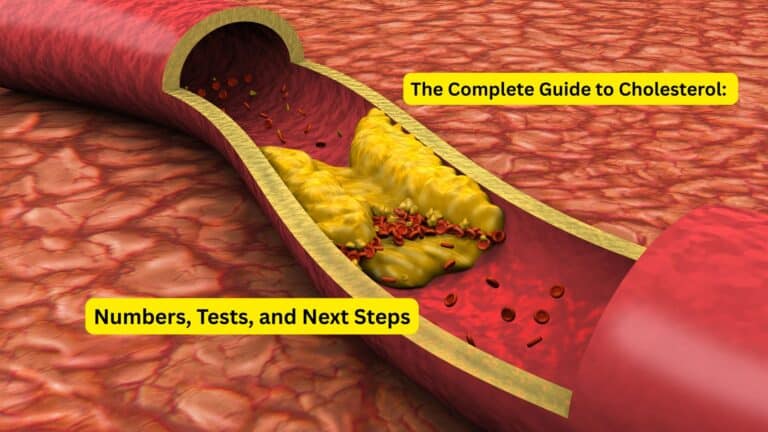Heart disease encompasses a broad group of conditions that affect the heart’s structure and function, making it far more complex than many people realize. As the leading cause of death worldwide, cardiovascular disease claims more lives annually than cancer, accidents, and respiratory diseases combined. Yet despite its prevalence, heart disease often remains preventable through early awareness, lifestyle modifications, and proactive health monitoring.
Understanding the various types of heart disease, recognizing warning symptoms, and identifying personal risk factors can empower individuals to take control of their cardiovascular health before serious complications develop. This comprehensive guide will help you navigate the complexities of heart disease and discover actionable steps toward prevention and early detection.
Common Types of Heart Disease
Heart disease isn’t a single condition but rather a collection of cardiovascular disorders, each with distinct characteristics and health implications. Recognizing these different types helps individuals understand their specific risks and appropriate prevention strategies. The most prevalent forms affect millions of Americans and can often be managed effectively when identified early.
Coronary Artery Disease (CAD)
Coronary artery disease represents the most common type of heart disease, occurring when the arteries that supply blood to the heart muscle become narrowed or blocked by plaque buildup. This process, called atherosclerosis, develops gradually as cholesterol, fat, and other substances accumulate along artery walls. When these coronary arteries become significantly narrowed, the heart muscle may not receive adequate oxygen-rich blood, leading to chest pain (angina) or potentially life-threatening heart attacks.
The danger of CAD lies in its progressive nature—many people develop this condition over years or decades without experiencing obvious symptoms. Nearly 1 in 5 deaths in the United States results from coronary artery disease, making early detection through routine screening particularly crucial for high-risk individuals.
Arrhythmias
Arrhythmias involve irregular heartbeats that can manifest as hearts beating too fast, too slow, or with an irregular rhythm. While some arrhythmias are harmless and temporary, others can signal serious underlying heart problems or increase the risk of stroke and sudden cardiac death. Common symptoms include heart palpitations, dizziness, shortness of breath, and in severe cases, fainting episodes.
These rhythm disorders can stem from various causes, including coronary artery disease, high blood pressure, diabetes, smoking, excessive alcohol consumption, and certain medications. Some individuals may experience occasional irregular heartbeats without any underlying heart disease, while others require medical intervention to prevent complications.
Cardiomyopathy
Cardiomyopathy involves the weakening or abnormal thickening of the heart muscle, making it difficult for the heart to pump blood effectively throughout the body. This condition can be inherited or develop due to other factors such as high blood pressure, heart attacks, viral infections, or certain medications and substances.
People with cardiomyopathy often experience fatigue, shortness of breath during physical activity, swelling in the legs and ankles, and irregular heartbeats. In advanced stages, cardiomyopathy can lead to heart failure, where the heart cannot meet the body’s demands for oxygen and nutrients.
Heart Valve Disease
The heart contains four valves that ensure blood flows in the correct direction through the heart chambers. Heart valve disease occurs when one or more valves don’t function properly due to narrowing (stenosis) or leaking (regurgitation). These problems can be present from birth or develop over time due to infections, rheumatic fever, or age-related wear and tear.
Heart valve disease may produce a heart murmur that doctors can detect during routine examinations. Other symptoms include fatigue, shortness of breath, chest pain, dizziness, and swelling in the feet or ankles, particularly when the condition progresses.
Congenital Heart Defects
Congenital heart defects are structural abnormalities present from birth that affect the heart’s chambers, valves, or blood vessels. These defects range from simple conditions that may never cause problems to complex abnormalities requiring multiple surgeries throughout a person’s lifetime.
While many congenital heart defects are diagnosed and treated during infancy or childhood, some individuals may not discover their condition until adulthood. Symptoms can include fatigue during exercise, shortness of breath, and in some cases, a bluish tint to the skin due to reduced oxygen levels in the blood.
Symptoms of Heart Disease
Heart disease symptoms can vary significantly depending on the specific condition and individual factors, making recognition challenging for many people. While some individuals experience classic warning signs, others may have subtle symptoms or no symptoms at all until their condition becomes advanced. Understanding the full spectrum of potential symptoms can help people seek appropriate medical evaluation when necessary.
Classic Symptoms
The most recognizable heart disease symptoms include chest pain or pressure, often described as a squeezing, burning, or heavy sensation in the center or left side of the chest. This discomfort may radiate to the arms, neck, jaw, or back and can last several minutes or come and go intermittently. Shortness of breath frequently accompanies chest pain and may occur during physical activity or even at rest in more advanced cases.
Heart palpitations, where individuals feel their heart racing, fluttering, or skipping beats, represent another common symptom. These sensations may be brief and harmless or persistent and concerning, depending on the underlying cause and frequency of occurrence.
Other Signs
Many heart disease symptoms extend beyond chest-related complaints, making them easily attributed to other conditions or dismissed as normal signs of aging. Unexplained fatigue that interferes with daily activities can signal reduced heart function, particularly when it develops gradually over time or worsens with minimal exertion.
Nausea, vomiting, lightheadedness, and cold sweats may accompany heart problems, especially during heart attacks. Swelling in the legs, ankles, feet, or abdomen can indicate heart failure, where the heart cannot pump blood effectively, causing fluid to accumulate in the body’s tissues.
Silent Heart Disease
Perhaps most concerning is the phenomenon of silent heart disease, where significant cardiovascular problems develop without producing noticeable symptoms. This asymptomatic progression can continue for years while plaque builds up in coronary arteries or other heart problems develop undetected.
Silent heart disease particularly affects people with diabetes, as nerve damage from high blood sugar can interfere with the heart’s pain signals. Regular screening becomes especially important for individuals at higher risk, as the first sign of silent heart disease may be a heart attack or sudden cardiac event.
Symptoms in Women
Heart disease symptoms in women often differ from the classic presentations more commonly seen in men, leading to delayed diagnosis and treatment. While women can certainly experience chest pain during heart attacks, they more frequently report nausea, vomiting, back or neck pain, jaw discomfort, and extreme fatigue as primary symptoms.
Women may also experience shortness of breath without chest pain, dizziness, unusual sweating, and a sense of impending doom during cardiac events. These atypical presentations contribute to women’s heart disease being underdiagnosed and undertreated, emphasizing the importance of awareness about gender differences in symptom presentation.
Risk Factors for Heart Disease
Heart disease risk factors fall into categories that individuals can and cannot control, providing a framework for understanding personal cardiovascular risk and developing prevention strategies. While some factors like age and family history cannot be changed, many lifestyle-related risks offer opportunities for significant risk reduction through targeted interventions and healthy choices.
Non-modifiable Risks
Age represents one of the strongest predictors of heart disease risk, with the likelihood of developing cardiovascular problems increasing significantly after age 45 for men and 55 for women. Male sex also increases risk, though women’s risk rises substantially after menopause when protective estrogen levels decline.
Family history and genetics play crucial roles in heart disease development, with individuals having parents or siblings who experienced early heart disease facing up to three times higher risk than those without family history. Certain genetic variations can affect cholesterol metabolism, blood pressure regulation, and other cardiovascular functions, influencing disease susceptibility from birth.
Modifiable Risks
Fortunately, many significant heart disease risk factors can be controlled through lifestyle modifications and medical management. High blood pressure, affecting nearly half of American adults, damages artery walls over time and forces the heart to work harder than normal. Similarly, elevated cholesterol levels contribute to plaque formation in coronary arteries, progressively narrowing these vital blood vessels.
Diabetes dramatically increases heart disease risk by damaging blood vessels and accelerating atherosclerosis development. Obesity, particularly abdominal weight, contributes to multiple risk factors simultaneously, including high blood pressure, diabetes, and abnormal cholesterol levels. Smoking damages blood vessels, reduces oxygen delivery to the heart, and increases blood clot formation risk.
Physical inactivity and poor dietary choices further compound cardiovascular risk. Sedentary lifestyles weaken the heart muscle and contribute to obesity, high blood pressure, and diabetes. Diets high in saturated fats, trans fats, sodium, and added sugars while low in fruits, vegetables, and whole grains promote heart disease development through multiple pathways.
Emerging Risks
Recent research has identified additional factors that influence heart disease risk beyond traditional considerations. Chronic stress and mental health conditions like depression and anxiety can contribute to cardiovascular problems through various mechanisms, including elevated blood pressure, increased inflammation, and unhealthy coping behaviors.
Sleep quality and duration also affect heart health, with both insufficient sleep and sleep disorders like sleep apnea increasing cardiovascular risk. Poor sleep can disrupt hormone balance, increase blood pressure, and contribute to weight gain and diabetes development.
Emerging genetic testing capabilities are revealing more specific hereditary factors that influence individual risk profiles, allowing for more personalized prevention strategies and monitoring protocols.
Prevention and Early Detection
Preventing heart disease requires a comprehensive approach that addresses modifiable risk factors while incorporating regular monitoring and early detection strategies. The good news is that many of the most effective prevention measures involve lifestyle changes that also improve overall health and quality of life. Early detection through appropriate screening can identify problems before they become serious, enabling timely intervention and treatment.
Lifestyle Modifications
The foundation of heart disease prevention rests on adopting and maintaining heart-healthy lifestyle practices throughout life. A balanced diet emphasizing fruits, vegetables, whole grains, lean proteins, and healthy fats while limiting processed foods, excessive sodium, and added sugars can significantly reduce cardiovascular risk. The Mediterranean and DASH (Dietary Approaches to Stop Hypertension) eating patterns have demonstrated particular benefits for heart health.
Regular physical activity strengthens the heart muscle, improves circulation, helps control weight, and reduces blood pressure and cholesterol levels. Current guidelines recommend at least 150 minutes of moderate-intensity aerobic activity or 75 minutes of vigorous activity weekly, along with muscle-strengthening exercises twice per week.
Smoking cessation represents one of the most impactful changes individuals can make for their cardiovascular health. Within just one year of quitting, the risk of heart disease drops significantly, and continued abstinence provides ongoing protection. Stress management through techniques like meditation, yoga, deep breathing, or counseling can help reduce the cardiovascular impact of chronic stress.
Testing and Monitoring
Regular screening and monitoring play essential roles in heart disease prevention by identifying risk factors before they cause symptoms or serious complications. Blood pressure checks, cholesterol panels, and blood sugar tests provide crucial information about cardiovascular risk and can guide prevention strategies.
Adults should have their blood pressure checked at least annually, with more frequent monitoring for those with elevated readings. Cholesterol screening typically begins at age 20 and should be repeated every five years for most people, though high-risk individuals may need more frequent testing. Diabetes screening becomes important for adults over 35 or earlier for those with risk factors.
Additional tests may be recommended based on individual risk profiles, including electrocardiograms (ECGs), stress tests, calcium scoring, or advanced lipid panels. These assessments can provide more detailed information about heart function and structure, helping identify problems in their early stages.
Walk-In Lab Role
Walk-In Lab offers accessible, confidential cardiovascular testing that empowers individuals to monitor their heart health without the need for doctor visits or insurance authorization. Comprehensive heart health panels can assess multiple risk factors simultaneously, including cholesterol levels, blood sugar, inflammatory markers, and other cardiovascular indicators.
The convenience and affordability of direct-access testing remove common barriers to regular monitoring, enabling people to track their progress as they implement lifestyle changes or manage existing conditions. Results can be shared with healthcare providers to guide treatment decisions and optimize prevention strategies.
Regular testing through Walk-In Lab can also help individuals understand their response to medications, dietary changes, or exercise programs, providing objective feedback on the effectiveness of their heart disease prevention efforts.
FAQs
What are the most common types of heart disease?
Coronary artery disease is by far the most prevalent type, accounting for the majority of heart disease cases. Other common types include arrhythmias (irregular heartbeats), heart failure, heart valve disease, and cardiomyopathy (heart muscle disease). Congenital heart defects, while less common in adults, represent another important category that can affect people throughout their lives.
What symptoms should I watch for?
Classic heart disease symptoms include chest pain or pressure, shortness of breath, fatigue, and heart palpitations. However, symptoms can vary significantly between individuals and may include nausea, dizziness, back or neck pain, jaw discomfort, and swelling in the legs or ankles. Some people, particularly those with diabetes, may have no symptoms until their condition becomes advanced, making regular screening essential.
Who is most at risk for heart disease?
Risk increases with age, particularly after 45 for men and 55 for women. Family history of early heart disease significantly elevates risk, as do conditions like high blood pressure, high cholesterol, diabetes, and obesity. Lifestyle factors including smoking, physical inactivity, poor diet, and chronic stress also contribute substantially to heart disease risk. However, people of all ages and backgrounds can develop heart disease, making prevention important for everyone.
Can lifestyle changes reduce my risk?
Yes, lifestyle modifications can dramatically reduce heart disease risk, even for people with genetic predisposition or existing risk factors. Adopting a heart-healthy diet, exercising regularly, maintaining a healthy weight, not smoking, limiting alcohol consumption, and managing stress can lower risk by 50% or more. These changes are often more effective than medications alone and provide additional health benefits beyond cardiovascular protection.
How can Walk-In Lab testing help?
Walk-In Lab provides convenient access to comprehensive cardiovascular screening without requiring doctor visits or insurance pre-authorization. Regular testing can identify risk factors like high cholesterol, elevated blood sugar, or inflammatory markers before they cause symptoms. This early detection enables prompt lifestyle changes or medical intervention to prevent heart disease progression. The affordability and accessibility of testing also allow for regular monitoring of progress as you implement heart-healthy changes.
Conclusion
Heart disease may be the leading cause of death worldwide, but it doesn’t have to be inevitable. Understanding the various types of cardiovascular conditions, recognizing both classic and subtle symptoms, and identifying personal risk factors provides the foundation for effective prevention and early intervention. While some risk factors like age and genetics cannot be changed, the majority of heart disease cases involve modifiable lifestyle factors that respond well to targeted improvements in diet, exercise, stress management, and other healthy behaviors.
The key to successful heart disease prevention lies in taking action before symptoms appear. Regular screening and monitoring enable early detection of risk factors, allowing for timely interventions that can prevent progression to serious complications. With proper awareness, lifestyle modifications, and appropriate medical care when needed, most people can significantly reduce their risk of developing heart disease or effectively manage existing conditions.
Don’t wait for symptoms to appear before taking control of your cardiovascular health. Order a Heart Health Panel from Walk-In Lab today to assess your current risk factors and establish a baseline for monitoring your progress toward better heart health. Your heart is worth the investment in prevention and early detection.
This article is for informational purposes only and does not constitute medical advice. Always consult with healthcare professionals for personalized medical guidance and treatment recommendations.






